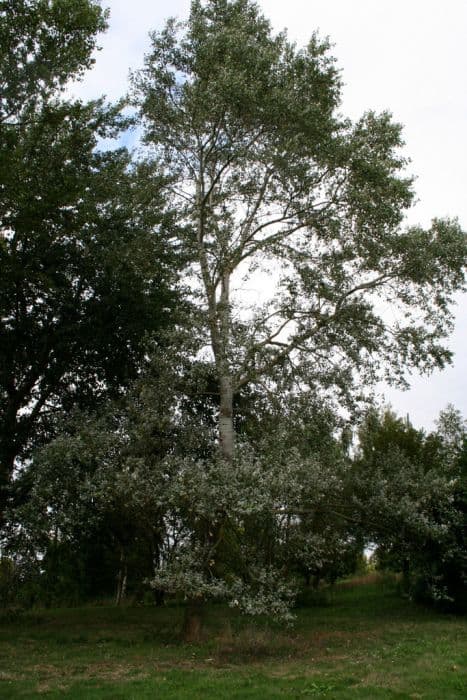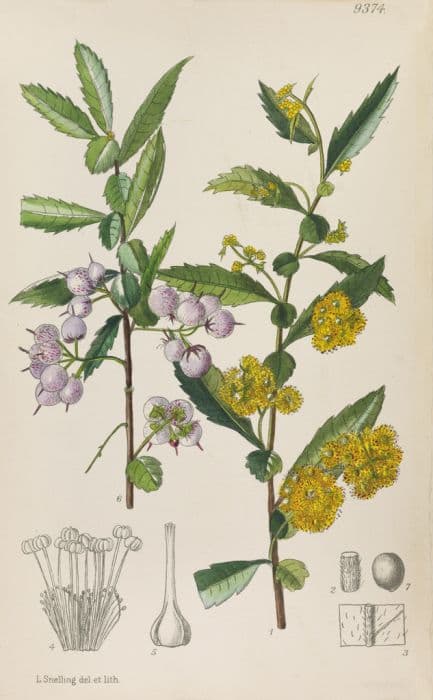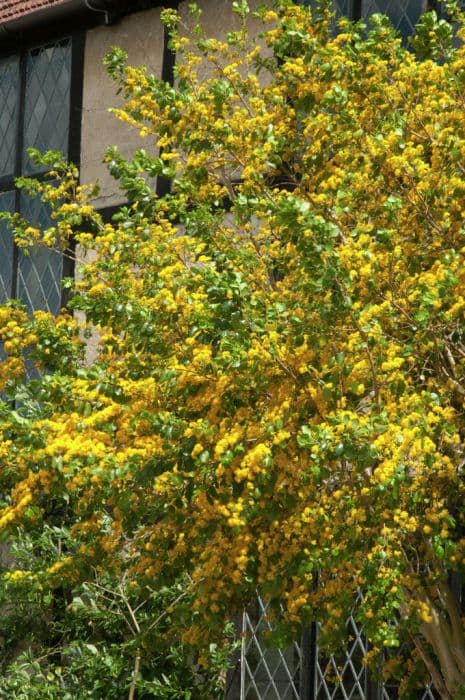Eastern Cottonwood Populus deltoides 'Purple Tower' (PBR)

ABOUT
The Purple Tower is a variant of the poplar tree, known for its unique foliage and elegant form. It boasts a distinctive columnar shape with a narrow, upright growth habit that makes it stand out in the landscape. The leaves of the Purple Tower are its most striking feature. In spring, the leaves emerge with a deep purple hue, catching the eye with their vibrant color. As the seasons progress, the leaves may transition to display a greenish tint while still maintaining hints of their initial purple tones. These heart-shaped leaves offer a lush and dense canopy, providing an attractive contrast against the typical greenery of other trees. The bark of the Purple Tower is relatively smooth with a greyish appearance, adding to the overall aesthetic appeal of the tree. In winter, when the leaves have fallen, the bare branches form an intriguing silhouette against the sky. With its unique purple foliage and statuesque presence, the Purple Tower is a popular choice for those looking to add a touch of drama and color to their landscape.
About this plant
 Names
NamesFamily
Salicaceae
Synonyms
Eastern Cottonwood, Purple Tower Cottonwood
Common names
Populus deltoides 'Purple Tower' (PBR).
 Toxicity
ToxicityTo humans
The common name of Populus deltoides 'Purple Tower' (PBR) is Eastern Cottonwood. Generally, Eastern Cottonwood is not known to be toxic to humans. Most parts of the tree, including leaves, bark, and wood, do not contain compounds that are considered poisonous upon ingestion. However, as with any plant material, individual allergies and sensitivities may exist, and ingesting plant parts is not advisable.
To pets
The Eastern Cottonwood is the common name of Populus deltoides 'Purple Tower' (PBR). This tree is not typically listed as toxic to pets. Both cats and dogs can usually be around this tree without concern for poisoning from ingesting its parts. Nevertheless, pet owners should prevent pets from chewing or ingesting plant materials, as they can cause gastrointestinal upset or obstructions and individual pets may have allergies or unique sensitivities.
 Characteristics
CharacteristicsLife cycle
Perennials
Foliage type
Deciduous
Color of leaves
Green
Height
50-70 feet [15-21 meters]
Spread
20-30 feet [6-9 meters]
Plant type
Tree
Hardiness zones
2-9
Native area
North America
Benefits
 General Benefits
General Benefits- Ornamental Value: 'Purple Tower' is known for its striking purple foliage that adds unique color and visual interest to landscapes.
- Shade Provider: As a large deciduous tree, it offers ample shade, making it suitable for parks, gardens, and urban environments.
- Wildlife Habitat: The tree can provide shelter and nesting sites for birds and small mammals, as well as a food source when it produces catkins.
- Erosion Control: The robust root system helps to stabilize soil and control erosion, particularly along riverbanks and other bodies of water.
- Climate Adaptation: Populus deltoides 'Purple Tower' is adaptable to a range of climates, making it a versatile choice for different regions.
- Fast Growth: This tree species is known for its rapid growth rate, allowing for quick establishment and benefits in terms of landscaping.
- Drought Tolerance: Once established, 'Purple Tower' has a degree of drought tolerance, making it suitable for regions with occasional water scarcity.
- Low Maintenance: It generally requires minimal care once established, aside from regular pruning to maintain shape and structure.
 Medical Properties
Medical PropertiesThis plant is not used for medical purposes.
 Air-purifying Qualities
Air-purifying QualitiesThis plant is not specifically known for air purifying qualities.
 Other Uses
Other Uses- The Purple Tower Poplar's wood can be used for creating lightweight objects such as matchsticks and packing crates due to its low density.
- Wood from the Purple Tower Poplar may be used in the manufacture of artificial limbs, offering a lightweight option for prosthetics.
- Its distinctive purplish leaves can be used in floral arrangements and garden art, bringing a unique color contrast to various designs.
- The tree's vertically fastigiate form makes it useful in landscape architecture for creating privacy screens or windbreaks with a decorative touch.
- Artists may use the tree’s fallen leaves as stencils or for leaf-printing projects due to their strong and recognizable shape.
- The bark of the Purple Tower Poplar can be used in ornamental crafts, such as creating textured surfaces on pottery or in bark painting.
- The wood's ability to bend well when steamed allows for the production of curved wooden furniture and decorative items.
- Dried twig and branch sections can be used as natural and rustic elements in home decor, such as candle holders or wall hangings.
- Because of its fast growth, the Purple Tower Poplar can be cultivated for biomass fuel production, serving as an energy source apart from fossil fuels.
- The leaves can serve as a natural dye source, providing fabric and wool a range of colors from yellow to green depending on the mordant used.
Interesting Facts
 Feng Shui
Feng ShuiThe Eastern Cottonwood is not used in Feng Shui practice.
 Zodiac Sign Compitability
Zodiac Sign CompitabilityThe Eastern Cottonwood is not used in astrology practice.
 Plant Symbolism
Plant Symbolism- Strength and Resilience: As Populus deltoides, commonly known as the Eastern Cottonwood, belongs to a species of large trees that are known for their strong wood and ability to withstand adverse conditions, they often symbolize strength and the ability to endure hardship.
- Growth and Transformation: With the 'Purple Tower' variety adding a unique coloration to the foliage, it brings to mind the idea of growth and personal transformation, as trees are commonly associated with continuous growth and change through the seasons.
- Flexibility and Adaptability: The Eastern Cottonwood has the ability to grow in varied environments and is known for being adaptable. This ability is often paralleled to human characteristics of being flexible and adapting to life's changing circumstances.
- Protection and Shelter: Trees in general are seen as protective symbols, providing shelter from the elements. The robust nature of the Eastern Cottonwood enhances this symbolism, suggesting a haven or sanctuary for those in need.
- Connection and Community: As a species that can often be found growing in groups, the Eastern Cottonwood could represent the interconnectedness between individuals and the importance of community and support systems.
 Water
WaterThe Purple Tower Poplar requires consistent watering to ensure its root system remains moist, especially during its first few growing seasons to establish a deep, extensive root system. Water the tree once a week, providing about 15 to 20 gallons per watering session for young trees. During periods of drought or extreme heat, the frequency may need to increase to twice a week. It's important not to over-water, as standing water or overly soggy soil can lead to root rot and other diseases. Adjust watering during the fall and winter when the tree is dormant, reducing the amount to match the tree's reduced needs.
 Light
LightThe Purple Tower Poplar thrives in full sun conditions, meaning it should receive at least six hours of direct sunlight daily. The best spot for the plant is in an open area away from buildings or other large structures that could cast significant shade. This tree does not perform as well in shaded or partially shaded environments, as insufficient sunlight can hinder its growth and foliage development.
 Temperature
TemperatureThe Purple Tower Poplar is adaptable to a wide range of temperature conditions once established. It can tolerate winter temperatures down to about -20 degrees Fahrenheit and is suited for the cooler to moderate climates typically found in USDA hardiness zones 3 through 9. Ideally, temperatures between 50 and 85 degrees Fahrenheit promote the best growth and health for the tree.
 Pruning
PruningThe Purple Tower Poplar should be pruned to maintain its shape and remove any damaged or diseased branches, fostering a strong structure. Pruning is ideally carried out during the dormant season, late winter to early spring before new growth starts. Young trees may require more frequent pruning to shape their growth, while established trees should be pruned every 3 to 5 years or as necessary to remove deadwood and maintain their aesthetic form.
 Cleaning
CleaningAs needed
 Soil
SoilThe best soil mix for the Eastern Cottonwood 'Purple Tower' is well-draining, loamy soil. It prefers a soil pH between 6.0 to 7.5. Amending the soil with organic matter can improve its structure and nutrient content for better tree growth.
 Repotting
RepottingEastern Cottonwood 'Purple Tower' trees are typically not potted plants and therefore do not require repotting. They are grown outdoors and can become quite large.
 Humidity & Misting
Humidity & MistingEastern Cottonwood 'Purple Tower' does not have specific humidity requirements as it grows best outdoors. It is adaptable to the humidity levels found in most environments where it can thrive.
 Suitable locations
Suitable locationsIndoor
Cottonwoods, like 'Purple Tower', are not suited for indoor growth due to their size.
Outdoor
Plant in full sun, water deeply; not for small gardens due to size.
Hardiness zone
4-9 USDA
 Life cycle
Life cycleThe Eastern Cottonwood 'Purple Tower' (Populus deltoides 'Purple Tower' PBR) begins its life cycle with seed germination in the spring, ideally in moist soil conditions. As a fast-growing deciduous tree, it quickly establishes a root system and sprouts shoots, developing into a sapling with characteristic purple foliage. Through the juvenile stage, the tree vigorously grows, maturing over several years and eventually reaching its full height with a columnar crown structure. During its reproductive stage, which can start as early as 10 years of age, it produces catkins—male flowers release pollen, while female flowers develop into capsules that release seeds. These seeds are dispersed by wind and water, facilitating the propagation of new plants. The 'Purple Tower' can live several decades but is relatively short-lived compared to other hardwoods, and will eventually enter senescence before dying, completing its life cycle.
 Propogation
PropogationPropogation time
Spring-Early Summer
Propogation: The 'Purple Tower' cottonwood, a variety of Populus deltoides, is often propagated through hardwood cuttings. The ideal time for propagation is during the plant's dormancy in late winter to early spring before bud break. A popular method involves taking cuttings from year-old growth that is about 1/4 to 1/2 inch (6 to 13 millimeters) in diameter and 8 to 10 inches (20 to 25 centimeters) long. The bottom cut should be made just below a node, and the top cut should be made above a node. The cuttings are then placed in moist soil or a rooting medium, ensuring that at least one node is below the surface where roots can develop while the remaining nodes are above for shoot growth. Cuttings should be kept in a bright, warm location but out of direct sunlight, and the medium must remain consistently moist. Roots usually develop within a few weeks to a few months, after which the cutting can be transplanted to a larger pot or to its final growing location.









